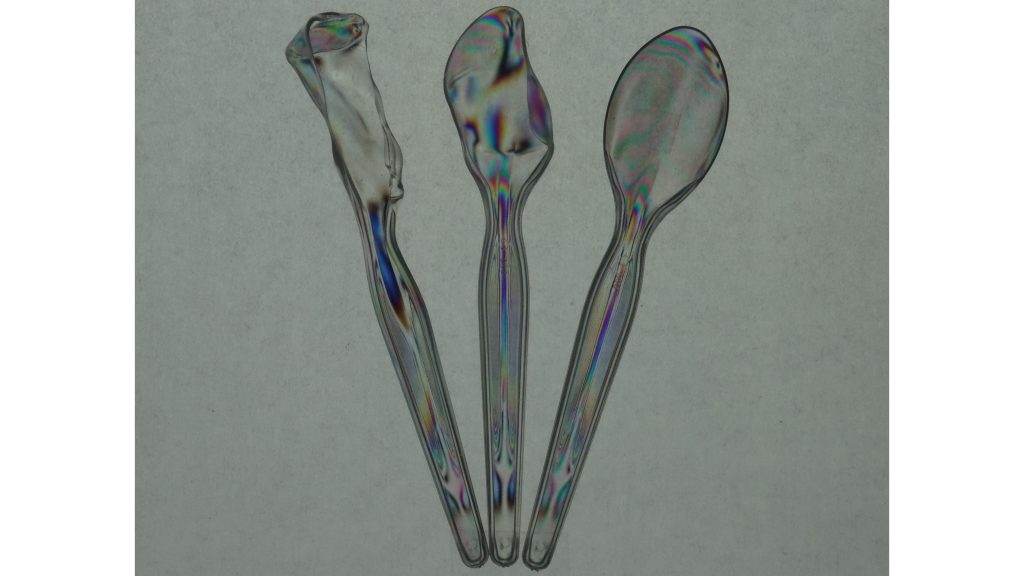From the Journal: American Journal of Physics
WASHINGTON, July 22, 2022 – The polarization of light underpins a variety of recent technological innovations, including 3D cinema and LCDs. In LCDs, tiny electronically controllable liquid crystal elements are sandwiched between polarizers. If, instead, other transparent polarization-altering films – like cellophane gift wrap and packaging tape – are placed between a set of polarizers, an array of polarization-filtered colors can be observed.
In the American Journal of Physics, by AIP Publishing, Aaron Slepkov, from Trent University in Canada, explores the physics of how such colors emerge, how they can be controlled, and why subtle changes in viewing angle, sample orientation, and the order of layers of films between polarizers can have dramatic effects on the observed colors.

The research emphasizes visual examples of concepts related to birefringence, such as addition, subtraction, and order-of-operations. For example, the noncommutative nature of birefringent addition is typically illustrated using formal matrix mathematics. However, in this case, the researchers use color visualization.
“I use a visual language of coloration to illustrate subtle physics that is often only demonstrated mathematically,” said Slepkov.
He was inspired, in part, by the work of artist Austine Wood Comarow, who made a career in applying polarization-filtered coloring techniques in fine art. Austine coined the term “polage,” or polarization of collage, to refer to her art.
Austine created a wide array of works using sophisticated layering of cut cellophane and other birefringent polymer films, interspersed with layers of film polarizers. Her pieces range from small stand-alone pieces that fit on a shelf to massive career-spanning installations in institutions, such as the Disney Epcot Center in 1981 and the Gyeongsangnam-do Institute of Science Education, in Jinju, South Korea, in 2017.
“In this work, I clarify the link between polarization filtering and the observed colors. I demonstrate how various aspects of birefringence in common household films provide opportunities and challenges for their use in art,” said Slepkov.
To create polarization-filtered color, all that is needed is a birefringent sample sandwiched between polarizers that form a polarization gate. Many household items can provide a kaleidoscopic array of colors and patterns.
Transparent plastic cutlery, for instance, provide a classic demonstration, where localized strain in the polymer structure results in differential birefringence, observable through a polarization gate. Likewise, somewhat randomly folded kitchen cling wrap, gift basket film, and layered adhesive tape can form intricate images reminiscent of stained-glass windows.
“The manipulation of birefringent films for the purpose of creating color images is fun and intellectually stimulating. Much of the nuanced physics of polarization, birefringence, retardance, and color theory can be observed in this accessible yet expansive endeavor,” said Slepkov.
###
For more information:
Wendy Beatty
media@aip.org
301-209-3090
Article Title
Authors
Aaron Slepkov
Author Affiliations
Trent University
American Journal of Physics
ABOUT THE JOURNAL
American Journal of Physics is devoted to the instructional and cultural aspects of physics. The journal informs physics education globally with member subscriptions, institutional subscriptions, such as libraries and physics departments, and consortia agreements. It is geared to an advanced audience, primarily at the college level. Contents include novel approaches to laboratory and classroom instruction, insightful articles on topics in classical and modern physics, apparatus, and demonstration notes, historical or cultural topics, resource letters, research in physics education, and book reviews.
ABOUT AAPT
AAPT is an international organization for physics educators, physicists, and industrial scientists—with members worldwide. Dedicated to enhancing the understanding and appreciation of physics through teaching, AAPT provides awards, publications, and programs that encourage teaching practical application of physics principles, support continuing professional development, and reward excellence in physics education. AAPT was founded in 1930 and is headquartered in the American Center for Physics in College Park, Maryland.
